#norah waugh
Text

When I was regathering my long-neglected research for my Helga Sinclair ribbon corset, I rediscovered this gorgeous extant example in the V&A from 1895. Unlike most extant examples I've come across, this one doesn't feature overlapping ribbons. This suggests that it was made for a particularly slim woman who needed very little support and for particular summertime breathability (supported by the garment waist measuring 19", suggesting a laced waist of 22-24".)
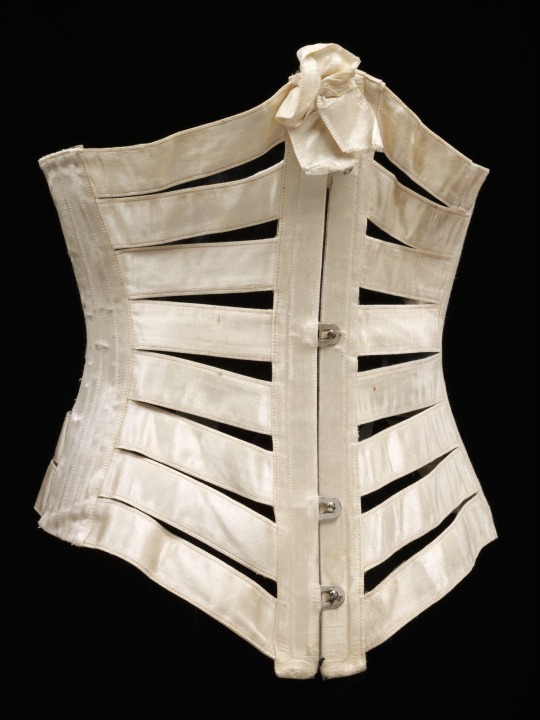

To me, long-since trapped in The Locked Tomb, the ribcage-like appearance was inescapable. Wouldn't you know it, I have a Crown Prince Kiriona Gaia costume that I started a year ago that was needing a little something something to pull the design together and to help motivate me.



The pattern was adapted from my Helga ribbon corset, allowing for 24mm wide ribbon to meet at the sides and spread evenly in a ribcage like fashion at the front panel.
This time I used a beautiful shell-coloured silk ribbon. The ribbon is so beautifully soft, that it was a nightmare to work with. I do not recommend it for something that needs quite so much working as it marked with so much as a hard look! I am fairly certain that the V&A example the ribbon is self-mounted, so I again mounted my main ribbon, this time on a white cottong taffeta ribbon. If i slipped with my mounting or the ribbon twisted or buckled, i thought the white would be a suitably stark and skeletal contrast to the main silk ribbon.
As I am perhaps a little more fleshy than the lady who owned the original 1895 example, I cheated and also added a base layer of nude tulle to help smooth out the laced-up silhouette.


The overall construction process was the same as Helga: quilted the ribbon panels across the boned panels before covering and sandwiching them, and inserting the bones from the side to allow for for hem stitching.
To finish, another ivory powder-coated busk and stitched over eyelets for security.

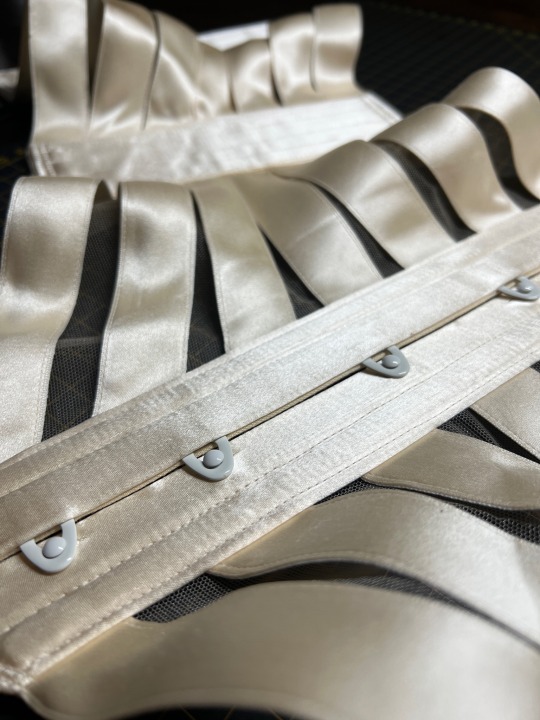
References:
Underwear Fashion in Detail, 2010, Eleri Lynn
Corsets - Historical Patterns & Techniques, 2008, Jill Salen
Corsets & Crinolines, 2017, Norah Waugh
1895 Ribbon Corset, V&A - https://collections.vam.ac.uk/item/O138887/corset-unknown/
How To Make A Basic Ribbon Corset, Sidney Eileen - http://sidneyeileen.com/sewing-2/sewing/corset-making/basic-ribbon/
An Edwardian Ribbon Corset, History Wardrobe - https://historywardrobe.wordpress.com/2014/04/10/an-edwardian-ribbon-corset/
#project: ribbon corset#project: crown prince kiriona#media: the locked tomb#the locked tomb#Nona the ninth#Gideon nav#Edwardian#historical sewing#historical dress#costume#cosplay#project wip#making of#poetry in costume
165 notes
·
View notes
Text
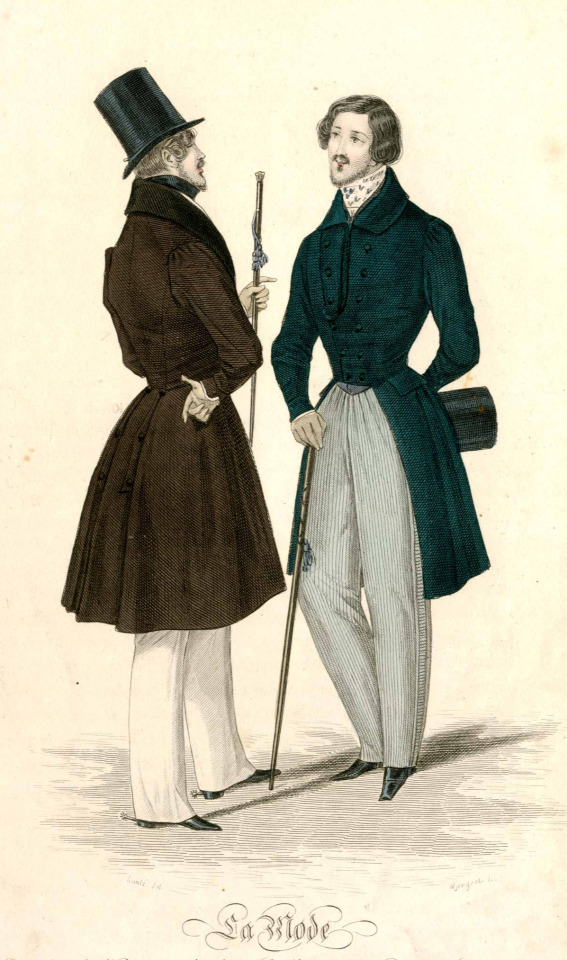
Fashion plate of 29 June 1833 in La Mode (detail), Met Museum. "Gloves, with both sexes, were now becoming conspicuous and important." — C. Willett Cunnington and Phillis Cunnington on the 1830s, in Handbook of English Costume in the 19th Century.
The gentlemen have yellow gloves, tassled canes, and wear frock coats with cinched waists. Sir Hardy Amies describes the fashion in his book The Englishman's Suit:
The frock coat appeared about 1830. It was probably of military origin as it fastened high at the neck and was usually double-breasted. It was the same length as the morning coat but the fronts were not cut away. By the middle of the century, Norah Waugh (again!) says, 'It now became a very worthy and somewhat dull garment, a coat for the well-to-do and professional classes — the hallmark of Victorian respectability'.
To accuse these Romantic fellows of ‘Victorian respectability’ seems harsh, but the Cunningtons describe a growing sense of prudery in the opening chapter to Handbook of English Costume in the 19th Century ("A View of the Century"):
In 1830 Leigh Hunt remarked that ‘so rapid are the changes that take place in people’s notions of what is decorous that not only has the word “smock” been displaced by the word “shift” but even that harmless expression has been set aside for the French word “chemise”, and at length not even this word, it seems, is to be mentioned nor the garment itself alluded to, by any decent writer’.
It was just at this time that parents began to discover additions to their families under gooseberry bushes; polite euphemisms for homely things were springing into use and in place of trousers gentlemen wore nether integuments, inexpressibles, unmentionables, ineffables or unwhisperables.

Frock coat-wearing men in Journal des Marchands-Tailleurs, December 1838: officially in the Victorian era now. (Well, maybe Monarchie de Juillet for these gentlemen).
#Eighteen-Thirties Thursday#1830s#fashion history#dress history#romantic era#frock coat#men's fashion#historical men's fashion#fashion#sir hardy amies#handbook of english costume in the 19th century#1833#1838#early victorian era
75 notes
·
View notes
Note
hi! do you or your followers have any book recs similar to Costume Close Up for 19th century/Victorian Era?
I don't know very many, since that's not my era! And are you looking for menswear, womenswear, or both?
Patterns of Fashion 1 and 2 by Janet Arnold both have 19th century women's patterns. Book 1 covers 1660-1860 and book 2 is 1860-1940. They have gridded patterns, very detailed drawings, and construction notes, but no photos. (You can look up photos of a lot of the garments in online museum collections though.)
Both The Cut of Men's Clothes and The Cut of Women's Clothes by Norah Waugh cover the entire 19th century, and they have pattern diagrams but barely any construction info.
I know there are also a number of actual sewing and pattern drafting books from the 19th century that you can find on places like google books and archive.org, but I've never read or used any of them.
19 notes
·
View notes
Text


I've felt pretty sick all day so I haven't been up to painting, but I'll hopefully be able to work on the historical drawing requests again soon! In the meantime enjoy this corset and chemise I made. Chemise is self-drafted and the Corset is based on a pattern from Corsets and Crenolines by Norah Waugh.
(Also yes Ik I did an Awful job curling my hair lol)
#historical dress#historical costuming#historical fashion#fashion#victorian fashion#victorian era#victorian#1860s fashion#1860s#corset#corsets#victorian corsets
24 notes
·
View notes
Text
Turns out we have two Janet Arnold and two Norah Waugh books in our fucking massive school library im throwing up
1 note
·
View note
Text
"Whatever Shall I Wear?" Book Review
June 10, 2021

[Image ID: a photo of the cover of "Whatever Shall I Wear?", which is a parchment color and has a blue ink illustration of a late 18th-century woman.]
"Whatever Shall I Wear? A Guide to Assembling a Woman's Basic 18th Century Wardrobe" is exactly what the subtitle says it is - a solid foundation for assembling a working-class woman's 18th-century wardrobe. It was written by Mara Riley, illustrated by Cathy Johnson, and published in 2002. It's aimed specifically at reenactors, but I think it's appropriate for any historical costumer interested in this topic.
"Whatever Shall I Wear?" is a short book (not quite 50 pages), but it contains a LOT of information. It dedicates at least a page each to shifts, petticoats, pockets, stays, bed gowns, jackets, gowns, aprons, handkerchiefs, caps, hats, shoes, stockings, cloaks, hairstyles, and jewelry. And that's just the beginning.
There's a whole section on fabrics (fibers, colors, patterns, and piecing), plus a page on basic hand stitching. The book acknowledges that sewing machines make assembling garments faster, but encourages (not commands) using hand stitches for anything visible, which is a common method among many costumers today!
Being aimed specifically at reenactors, there are discussions about weathering your wardrobe and making it fit your persona, including tips for how to adapt to various cultural backgrounds (namely French, German, Scottish, and Irish, though it also discusses what enslaved Africans wore). It should also be noted here that some sections near the end use what is now considered a slur against the Romani people.
The book ends with an annotated reading list, divided by topic, and including some well-known books and authors, such as Janet Arnold, Nancy Bradfield, Norah Waugh, "Fashion in Detail" from the V&A, and more. There's also a short list of relevant merchants, some of which I know are still around today, like J.P. Ryan, Kannik's Korner, and Burnley & Trowbridge.
And the illustrations!!! Cathy Johnson, the illustrator, created wonderfully intricate ink drawings to illustrate the clothing described. She drew on (haha) paintings and engravings from the era as well as extant garments to showcase styles from throughout the 1700s.
Overall, "Whatever Shall I Wear?" is a great starting point for anyone who wants to understand what working-class women wore in the 18th century! The book can be bought from many online retailers that cater to 18th century reenactors, or directly from Cathy Johnson's website.
Stay warm. Stay safe. Stay healthy.
0 notes
Text
Making a Robe à la française
Because I want to :)
Part I
We all have those dream projects we keep coming back to every now and then. Mine usually change every few months and so get discarded, but reconstructing an historical gown is something that has been living in the back of my mind for years, maybe even before I started sewing.
Ideally, I'd start with something more reasonable, like the Regency period. But I can't help obsessing over 18th century gowns, especially over decorated Robes à la française. I just keep getting back to those.
My mental health is... terrible, to say the least, so I already know that this project is going to take ages for me to complete it. If I manage to complete it at all. But I found that external validation helps, which is why I decided to blog about it.
And so... here goes nothing!
The inspiration
One of the reasons why it took me quite a while to get started was that I didn't really know what I wanted my final result to look like. I have never wanted to make a specific historical reproduction, but you gotta start somewhere.
A couple of years ago (like, more than four) I found these old curtains in my gradma's old house. I I thought they would be perfect a robe, but I still didn't know where to start.
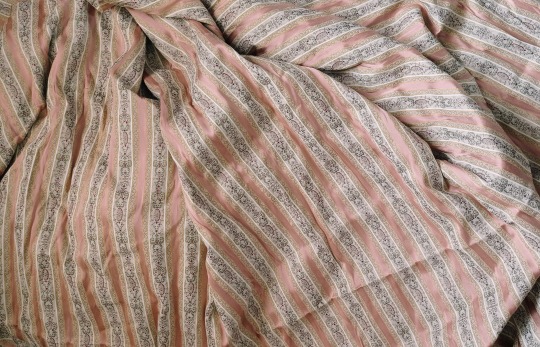
Luckily, mindlessly scrolling intagram isn't always useless (well, it is except for this one instance, but I digress), because I came across this dress on @/katestrasdin's page
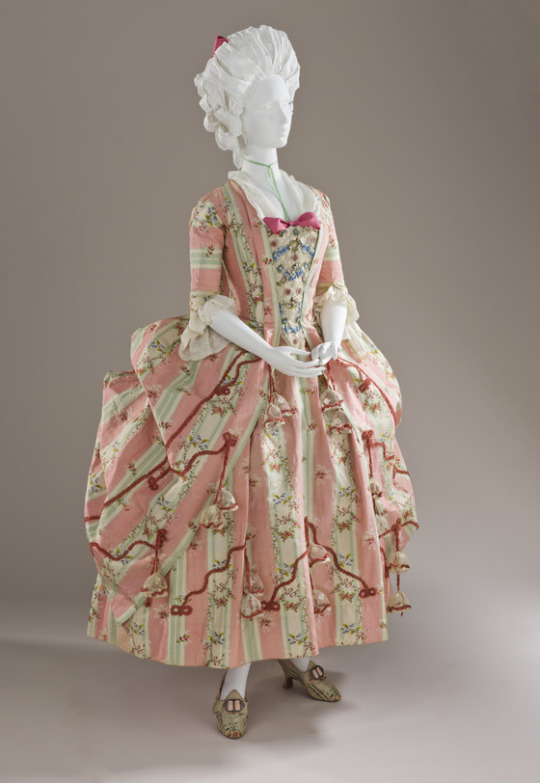
After some digging (aka a google image reverse search) I found out the dress is owned by LACMA. Despite being the second image that comes up when you google "Robe a la Polonaise" (via Wikipedia) it's described by the museum as a Woman's Dress and Petticoat (Robe à la Française)" from Spain, circa 1775.
My goal is to make something similar to this, as far as decorations go. The structure should be more "à la Française", so without the draped back à la Polonaise and with a floor lenght skirt. But we'll see.
I'll try to use a patten from Norah Waugh's "The Cut of Women's Clothes" from a 1740-50 Sack Dress.
Since I had no idea how such a pattern worked I started by tracing it on a piece of paper and draping it on a small mannequin, just to have a rough idea of what I was getting myself into. The process gave me flashbacks to the Alexander McQueen paper doll I built in lockdown (if you have a few minutes to a few hours to spare, please check it out here). Nevertheless, I now feel a bit more confident about the whole thing. It can be done


The undergarments (and my plan of action)
This kind of dress needs to be built on the undergarments/understructures. That means they they need to be made before the actual dress. At the same time, making undergarments that are (a) never going to be seen by anyone and (b) pretty difficult to make isn't the most exciting thing in the world.
Weirdly enough, I already made a pair of stays in 2021. They're far from perfect, quite ugly and very much not historically accurate. But the shape is there and they'll do the job, at least for now.
The other most important part are the pocket hoops. It's what I should work on next, but I think I'll actually make a mockup of the dress first, as i want to see how much volume I'll need. Then I'll make the pocket hoops.
Then I'll probably make a mockup of the petticoat to use as an under-petticoat. At this point I should know whether I have enough fabric to make the main petticoat of the same fabric of the dress or not. Then the main petticoat itself and then, hopefully, the dress.
Somewhere in between all of this I should make a shift as well, but it's not vital for the process, so I suspect I'll end up procrastinating it as much as possible
Easy peasy, right?
Right, wish me luck :)
Other stuff
It's not going to be historically accurate. I am starting from historical sources, and I'll try to follow them as much as possible, but in the end I just want to have fun and make a nice dress without too much stress. I will keep the hand stitching to the bare minimum and I'm pretty certain that my fabric is synthetic :)
I'm going to keep it as cheap as possible. Reuse, recycle and r...ice? Idk, you get the idea. I am not invested enough to put hundreds of euros in a project that I'll wear maybe once. And I think that sewing and crafts should be more accessible anyways
Resources
The Cut of Women's Clothes: 1600-1930 by Norah Waugh
Woman's Dress and Petticoat (Robe à la française) (LACMA)
0 notes
Text
Corset Reference Books
Cunnington, C. Willet and Phillis Cunnington. The History of Underclothes. New York: Dover Publications Inc., 1992.
Ewing, Elizabeth. Dress and Undress: A History of Women’s Underwear. New York: Drama Book Specialists, 1978.
This book is full of drawings, images, and text that detail women’s undergarments from 3000 BC to 1978. It is an excellent resource to understand corsets throughout the time that they were popular, alongside other undergarments and support garments that were being worn. It is also a source where the reader can watch changes in terminology—such as from stays to corsets.
Dress and Undress by Elizabeth Ewing—a fashion historian and journalist—is based on a previous publication by Ewing and is a detailed timeline of women’s underwear throughout most of modern history. Each chapter follows a certain garment within the timeframe it was most worn and tracks the details of its changes, who was wearing it, and what was (or wasn’t) worn with the garment. There is also a bibliography for both the US and the UK and an index. This resource is great for readers who want a deep understanding of the history of women’s undergarments.
Lord, W. B. The Corset & the Crinoline: An Illustrated History. Mineola, New York: Dover Publications, Inc., 2007.
This book is a republished version of an 1868 book by similar name. It is almost entirely text, though there are a few accompanying fashion plates. It follows the change in undergarment fashions from ancient civilization through to shortly after 1865. There seems to be a fascination with tight lacing, as that subject appears in almost every chapter. This source is valuable because while it is a reference on corsets, it is also of the era and thus without a modern-day bias. It is, however, by a man which is important to note only in that he would not have been the target audience for much surrounding corsets.
The Corset & the Crinoline is a book by William Barry Lord, a British author who wrote a wide variety of texts. This book is about the corset, and lesser so the crinoline, throughout history and as they came to popularity in women’s fashion in the 19th century. The chapters are organized chronologically, and when approaching the time in which it was written, breaks into different chapters for France and England. There is also an index. This text is intended for those with an interest in fashion history, especially undergarments such as the corset and crinoline, but probably best for those who already have a general understanding as Lord writes with an obvious distain for corsetry.
Steele, Valerie. The Corset: A Cultural History. New Haven: Yale University Press, 2001.
This book is mostly text, though it also includes an abundance of cartoons, advertisements, and photos of and about corsets. The book focuses on corsets from the 19th century onward in the context of their cultural effect on the populace. Its subjects include tight-lacing, satin corsets, and corset controversies. This book is a resource for those looking to go beyond the general knowledge of what corsets were as a garment.
The Corset: A Cultural History is a monolith by the renowned fashion historian Valerie Steele. It is about corsets and the cultural impact on subjects like iconography and the whaling industry. While it is slightly chronological, it is mostly organized by topic with chapters on things like “The Hard Body: A Muscular Corset” and “Dressed to Kill: The Medical Consequences of Corsetry”. There is also a selected bibliography and an index. This book is intended for a fashion historian-adjacent audience.
Waugh, Norah. Corsets and Crinolines. Edited by Judith Dolan. London: Routledge, 2018.
0 notes
Text
Sunday in the Park - Week 1

Following Moon Licks, I was determined to re-establish my boundaries in a better attempt to look after myself. Luckily, the costume team formulated for the musical was large enough to take a step back from responsibilities. This meant allowing others to handle the administrative tasks so I could focus on making tasks.
I was excited to finally work on a musical as I have a great interest in exaggerated, larger-than-life costumes, particularly trick costumes that are more common in musical theatre. They greatly appeal to my problem solving nature as a maker as I enjoy the challenge of blending my historical knowledge with camouflaging the mechanics required. I often spend free time studying on-stage quick changing costumes, so I was very much looking forward to putting that to good use!
In a prior conversation with the other maker on the team, we had agreed to split the work required, she would focus on the bodices and I would take the skirts. As she was more focused on historical makes, I felt this suited us well. This musical in particular would rely quite heavily on the making team as the goal of this production was to re-create Seurat’s painting ‘A Sunday Afternoon on the Island of La Grande Jatte’ as faithfully as possible. Initially with the brief of one bodice and two skirts, this felt quite comfortable but other makes were eventually added to the requirements later in the production schedule.
Both skirts requested by my designer were intended to do different tasks. Firstly, one with a detachable bustle that would stand in place to simulate an ‘out of body’ experience while the leading lady sang; and the other with an attached bustle she could pivot the waistband to become a baby bump in a shock pregnancy reveal.
It was decided that the detachable bustle would be handled first, as not only did it appear in the first scene - and would require a rehearsal version as soon as possible - but the structure of the creation would go against the actual design of a bustle. Historically, a bustle would never actually touch the floor, so the idea of it having to act as a free-standing structure complicated matters. So following a conversation with our supervisor, who recommended using castors to get the structure onstage as seamlessly as possible, I drew up a potential design of a wooden structure on wheels inspired by Norah Waugh’s Corsets and Crinolines, a selection of Janet Arnold’s pattern breakdowns as well as a gardening cage.
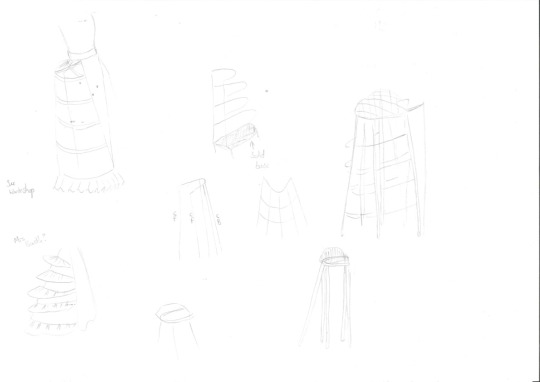
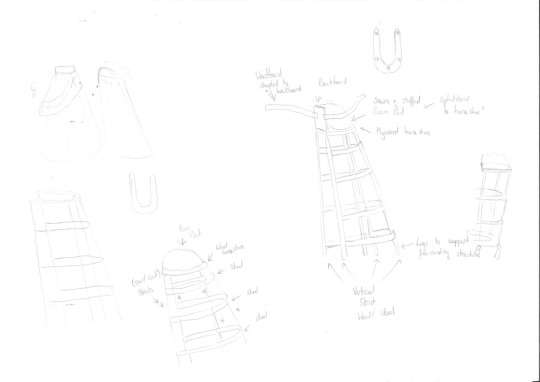

With this design, I felt like with the appropriate half skirt on top would give the correct silhouette and move in a way that would not give away the trick too early. However before I could speak to lecturers and technicians in the workshop, our pattern cutting tutor pointed out how weighty this kind of structure would be. Following that discussion, the design had completely completely changed to made of steel boning, foam and cardboard covered in fabric in a cross between a cage skirt and a bustle. I was a bit disappointed to have missed an opportunity to learn how to use the workshop equipment but I understand why this wasn’t feasible.


In the meantime, I got to work on what was dubbed the ‘painting skirt’, the maternity skirt would double up as the one to be featured in the titular painting. As the character of Dot was featured in the foreground, there was a greater scrutiny of accuracy. Once we had come to the conclusion that the vertical fold lines in the skirt were too regimented to be gathered, I went away and made a box pleated skirt. Honestly, I impressed myself in how quickly I managed to make this up. Over one afternoon, I had cut, pleated and sewn the skirt without getting distracted. Using a bit of ingenuity, I managed to fashion a make-shift bustle using half of a set of panniers and a bum pad in order to lay the skirt over and mark the hem correctly.
0 notes
Text
My Crimson Peak Costume
So Crimson Peak is one of my favorite movies and a huge part of that is the costumes. Kate Hawley did such an amazing job designing them. Anyway I've been obsessed with all of Edith’s outfits ever since I saw the film for the first time but I specifically love the Green velvet jacket she has on for literally one scene.

So after wanting this jacket for like 5 years I finally decided to make it.
For the pattern I used a combination of this pattern from The Cut of Women's Clothes by Norah Waugh and Butterick B6400. I definitely could have just used the Waugh pattern but I was feeling lazy and didn't want to have to size up the whole pattern.
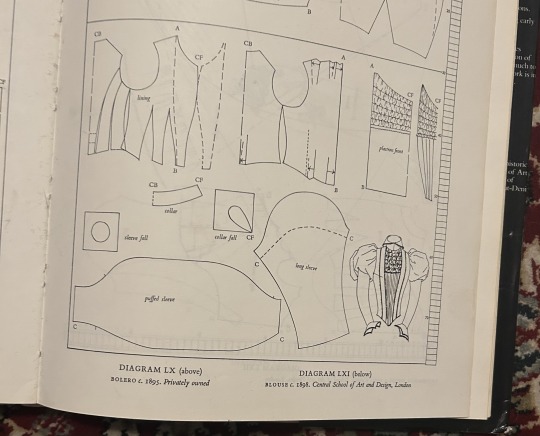
Hunting down the fabric for this was kind of difficult. The green velvet was easy, but I did have to go back to the store because I didn’t get enough the first time, but it was impossible to find fabric that was the right color yellow for the skirt without being super shiny and gross. Eventually I found some that I guess I missed the first few times I went to Joann's so it was all good. I also got some yellow stretch velvet for the grape trim on the shoulders. I actually think I found the exact vintage millinery trim that they used for the movie on Etsy but they only had one in stock so I had to make my own.
For the skirt I used this tutorial on youtube and I ended up adding a few more panels in the back since I had some more fabric. Then I made the same skirt two more times with some scrap fabric for some petticoats. I also made a bustle pad using this video although I didn’t have the pattern they used so I just eyeballed everything. I'm actually not 100% happy with how the silhouette of the skirt looks right now but I think that it's because the bustle pad isn't full enough so I may remake it.
Overall I'm really happy with how this turned out! I haven’t done a big sewing project in a while so it was nice to get back into it even if I did stab my fingers a lot when I was hand sewing everything lol! Now I just need to find a spooky gothic mansion around here so I have somewhere to wear this!

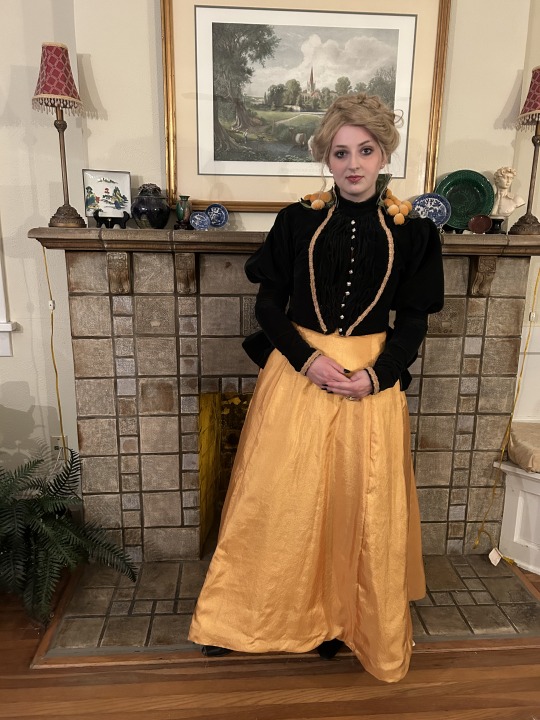
0 notes
Photo



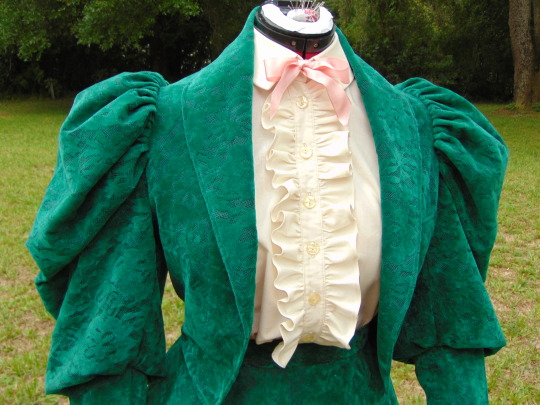
The 1895 Bolero Jacket, taken from pattern diagram LX in Norah Waugh’s “The Cut of Women’s Clothes”.
This is the first time I’ve made this one, and it actually went together much easier than I expected. These scaled down pattern based on museum pieces are often hit and miss with their accuracy. I made the skirt from a Butterick pattern and the blouse from a Truly Victorian blouse pattern #494, without the sleeves.
4 notes
·
View notes
Note
I want to a ttempt doing a wishing dress but I am not sure where to start with the pattern, most of my historical pieces have been roccoco/late 18th century, but I just found out that my school's library has: The cut of women's clothes,1600-1930 do.you think any of the late 19th century patterns would be a good base for my pattern?
I don’t have the Norah Waugh book “The Cut of Women’s Clothes” at hand, so I can’t tell whether there are matching patterns in there. But with those suggested underneath, you could see if there is someone you think is corresponding? Jean Hunnisett’s “Period Costume for Stage and Screen” is also often carried by libraries and can be very helpful. Not just in patterns, but also in sewing tips.
I also always recommend Truly Victorian. They have several patterns that’ll be good, given a small tweak or two. For example their TV405 vested bodice, or the TV462 tail bodice. For skirts, the TV208 trained skirt ensemble, the TV362 draped overskirt or the TV303 side drape overskirt.
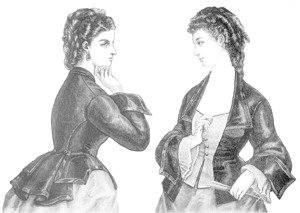
For their full catalogue, check: https://www.trulyvictorian.net/womens-sewing-patterns/
Anyhow, the basic elements for the Wishing dress is the main skirt, the draped apron, the side paniers, the waterfall backdrape and the vested bodice with engageant sleeves. In addition you need a bustle or bum roll or another construction giving that nice bump in the back. There might be different details depending on which version you want to recreate - like, the endless velvet trims on the US versions, or the just-as-endless tassel trims on the European ones, or the pleated main skirt in the World Tour versions. So have a look at that before choosing the materials. But also, have fun when making it! :)
25 notes
·
View notes
Note
I have been told by @benjhawkins that you are a good person to ask about Western men’s fashion in the 18th century.
I’m hoping to phrase this as delicately as possible: why were men’s breeches so unappealingly baggy in the seat while the thigh was so carefully tailored to fit the leg?
Thank you for any insight you can give!
For reference: the fellow in red

Hello and thank you for the intriguing question! I'm more of an 1810s person (hence the perpetual Napoleonic/War of 1812 vibes around here), but always willing to attempt to answer fashion history questions, especially ones about the early-mid 19th century. I'm not a professional dress historian, just interested in the subject.
I turned to Farid Chenoune's A History of Men's Fashion, which doesn't comment much on the tailoring of fashionable men's breeches except to emphasise their tightness. The Mémoires of one Baron de Frénilly are quoted:
Breeches, to be fashionable, had to be so tight that one needed help to get into them, skill and prudence to walk and especially to dance in them, talent to sit down or bend over with them—any heedless movement exposed one to the risk of disaster.
Chenoune has a visual timeline for western men's fashion printed on the endpapers of his massive book, and these are the earliest ones (he begins in the era of 1760-1850):
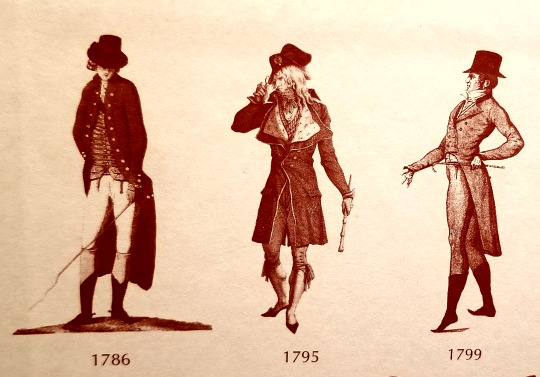
Tight breeches, of course, and also long coat skirts. It's the latter that makes me think of @/ellie-valsin’s masterpost on 1830s men’s bottom layers. It’s significantly later than the time period that you’re asking about, but it specifically addresses men’s trousers and breeches cut with a baggy seat, and proposes fluffing out the coat skirts as the main reason, fashion-wise (and to give the poor man just the slightest bit of ease in his tight pants, maybe).
Norah Waugh’s book The Cut of Men's Clothes 1600-1900 has many quotations from contemporary sources, and one attributed to Town and Country Magazine of 1772 has this to say about foppish Macaronis:
They make a most ridiculous figure with hats of an inch in the brim, that do not cover but lie upon the head, with about two pounds of fictitious hair, formed into what is called a club, hanging down their shoulders as white as a baker’s sack. The end of the skirt of their coat reaches the first button of their breeches which are either brown-striped or white, as wide as a Dutchman’s
Possible evidence for padding out the coat skirts? Plenty of contemporary sources attest to men not wanting to appear too thin, e.g. using calf padding. In the next section of The Cut of Men's Clothes, focused on the 19th century, Waugh writes, “Whereas the eighteenth century was characterized by its attention to cut, the nineteenth was notable for its concentration on fit.” Did tailors move away from baggy behinds due to improving techniques? (And after the 1830s, the silhouette for men starts moving away from an hourglass to boxy mid-century looks).
Unfortunately all of the period tailoring manuals that come to mind are 19th century vintage, but maybe one of my readers is more knowledgeable about the Georgian Gentleman’s baggy breeches. (Please chime in!)
#ask#fashion#fashion history#historical men's fashion#men's fashion#breeches#georgian fashion#18th century#1780s#1790s#my military uniform books don't touch on baggy seats#but one can assume that officers would follow the civilian fashion#dress history#farid chenoune#norah waugh#pentecostwaite#asks
91 notes
·
View notes
Photo
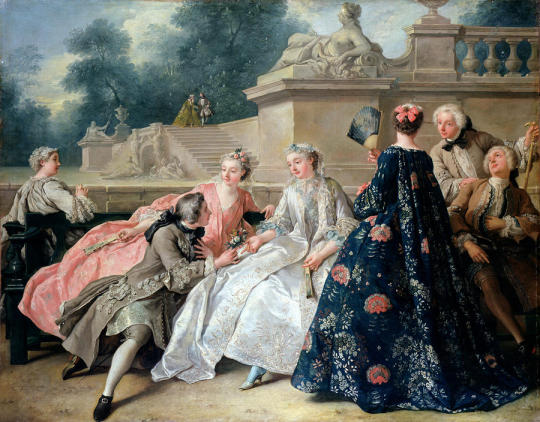

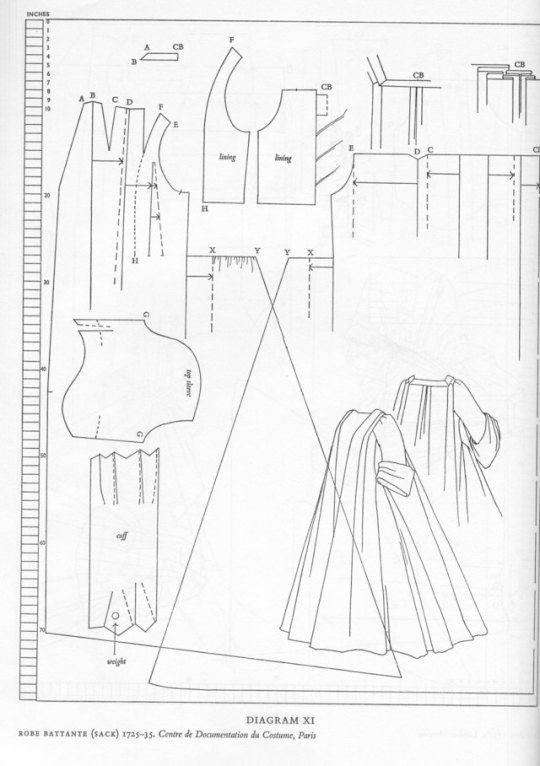
Robe Volante.
Do you remember that ask about what happened between the late 17th century and the most recognizable garments from the 18th century?
Part of that answer is this other post, but after that fashion in womenswear we have this: the robe volante (a.ka. robe battante, adrienne, contouche, innocente, flying dress...). Wide, flowy, keeping the back pleats from the mantua (and setting the bases for the robe à la française) this dress was the perfect silhouette for the big patterned fabrics in fashion at the beginning of the 18th century.
This silhouette is perfect for the period from 1720-1740s.
Images:
“The Declaration of Love”, 1731, Jean-François de Troy, National Gallery of Art, Washington DC.
Robe Volante, c. 1730, Museum of Fine Arts, Boston.
Robe volante pattern, from “The Cut of Women's Clothes: 1600-1930″ by Norah Waugh.
#early 18th century#1730s#fist half#1720s#1740s#robe volante#womenswear#blue#blue womenswear#jean-françois de troy#1731#museum of fine arts boston#norah waugh#the cut of women's clothes: 1600-1930#book#pattern#now you can do one yourselves
494 notes
·
View notes
Text

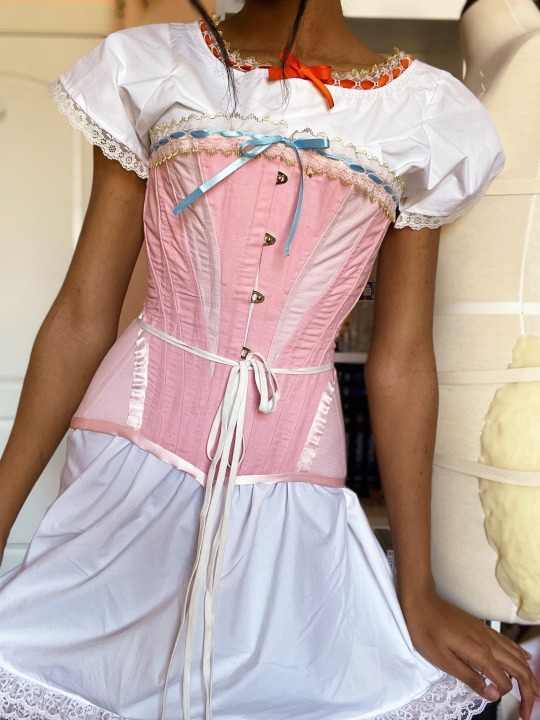

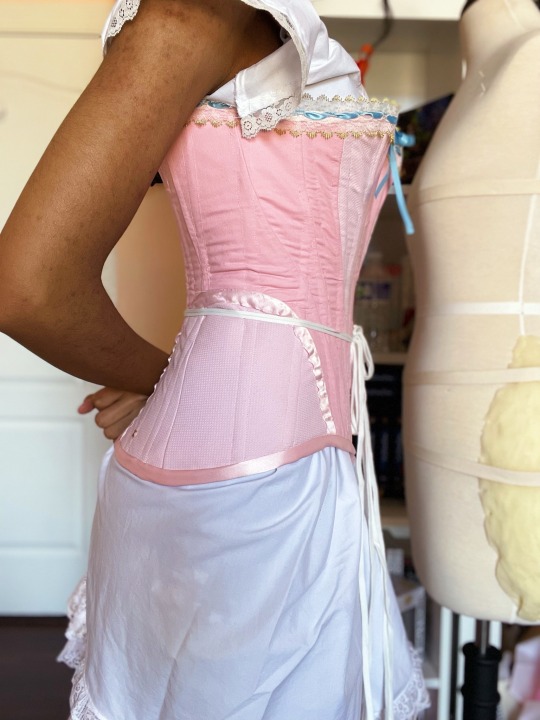
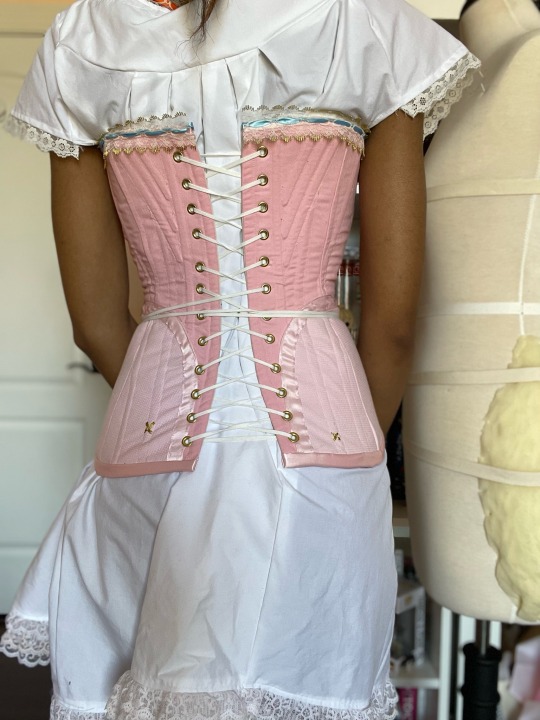
I haven’t posted anything costume/cosplay related here in a while, so here’s the corset I spent all Spring Break 🥲 making for this Peach cosplay I want to put together + a comparison to the Daisy corset I made last year for a similar purpose
Bonus!! The design concept and the mock-ups that led up to the real corset
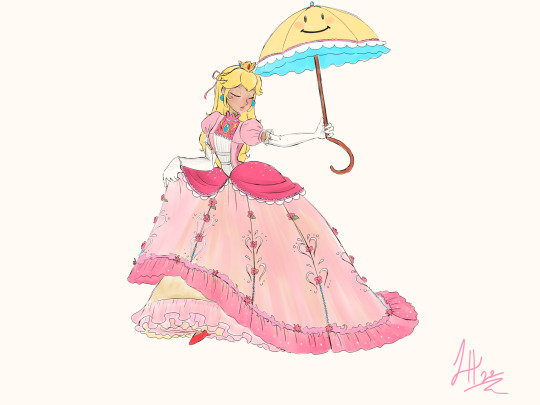
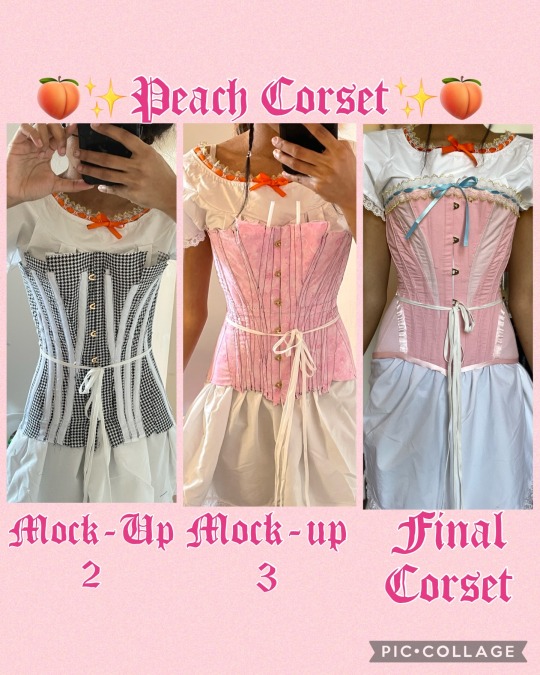
#I’ve also got this REAL BAD urge to share what I made but I don’t want to post on Insta since it’s not peak hours LOL#so Tumblr gets to see it first yay#corset#corsetry#custom corset#made by me#patterned by me#historical corset#historically inspired#inspired by Norah Waugh’s 1901 corset from Corsets and Crinolines#I patterned it from a sloper that I got from Foundations Revealed MANY years ago#It’s not perfect but I think I know what to do to fix it if I ever made another one#cosplay#cosplayer#cosmaker#cosplay wip#amateur corsetry#student costumer#college cosplayer#Princess Peach#Fan design#costume design#I’m still learning how to identify eras so forgive any accidental inaccuracies with the corset and Peach design#we haven’t even gotten to identifying silhouettes in the course yet LMAO
13 notes
·
View notes
Text
drew this fucking grid by hand now my wrists hurt so much. cringe bones and their cringe arthritis.

1 note
·
View note